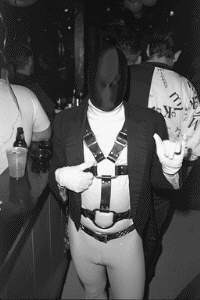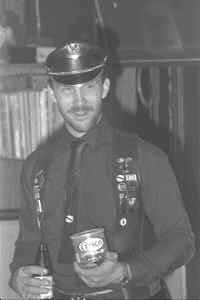



Origins
By
rand@coolcatdaddy.com/
|

|
SM can involve fetishes (sexual attachment for certain types of clothing or situations), the exploration of various types of body stimulation, or, in the words of member Kevin Drewery, "the exploration of power exchange issues in a sexual dynamic." Some individuals, such as TLC members Stuart Norman and Steve W., use SM as part of their spiritual practices to explore the limits of mind and body. SM, in all cases, is conducted between consenting adults and the goal is not, as in sadomasochism, bodily injury. There are currently over six hundred Leather/SM clubs and organizations in the United States, with a half-dozen in North Carolina alone. How did these clubs originate? To see the beginnings of Leather clubs, one has to go back about fifty years. Before the War, individuals who were interested in SM were not organized in any recognizable (or at least historically documented) fashion ñ they met secretively through a network of friends or very carefully-worded personal ads. World War II uprooted millions of people all over the world. People from small towns in the United States, Canada, and European countries were uprooted and exposed to other peoples and cultures. Two threads came together to form the modern Leather community, the images associated with Leather, and the organized Leather/SM clubs ñ the formation of the early "outlaw" biker clubs and the coalescing of the Gay and Lesbian communities in large cities like Chicago, San Francisco, and New York. Stuart Norman, a founding member of TLC who has been researching the origins of the Leather community noted that some men who returned home from the War did not fit into the effeminate Gay male stereotypes, so common in the fifties. These men were naturally attracted to the more "free" lifestyle of the bikers, many of whom were themselves were seeking the same type of male bonding and sense of adventure they saw during their service. The early Leather clubs were, in fact, outlaw biker clubs. |
|
Today, Leather/SM clubs bear a striking resemblance to their "biker" cousins in the structure of their organizations; the image that combines working class tee-shirts, boots, and jeans with biker leathers; and their very independent spirit. (Leather clubs even have "colors" -- a logo patch for the club that is worn on the back of a vest and Leather club members may collect pins from various Leather events or other clubs on the vest as a kind of "personal history", similar to club "colors" and vests worn by bikers.) A few Leather/SM clubs consist of Gay bikers, but most are social clubs. Some focus on community education about Leather/SM issues or Safe Sex, others on fundraising, and still others on political action. Some are male or female-only, primarily gay or heterosexual, others are "pansexual", open to men and women of any sexual orientation. The Tarheel Leather Club, drawing its early membership from Leatherfolk of the Triad who had lived in various parts of the country and experienced many different types of Leather organizations, combines many of these elements - education, fundraising, politics, mutual support and provides an interesting look at a group that is both unique and typical of Leather organizations all over the United States. TLC came together in the Spring of 1990, formed by nine individuals brought together by two very different events. Members Bill, Michael, and David Wr. Participated in the Southeast Leather contest in Atlanta and, wanting to see a club in their own area, began networking to see who might be interested. "Other places could have clubs", David said, "- if Wilmington could have a club, if Charlotte could have a club, there used to be one in Durham, why not one in Greensboro?" Members Stuart and Kevin participated in the Southeastern Conference for Lesbian and Gay men held in Raleigh. Shortly after, they and others held the first meeting of what would become the Tarheel Leather Club. |

|